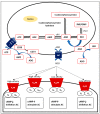Focusing on Adenosine Receptors as a Potential Targeted Therapy in Human Diseases
- PMID: 32213945
- PMCID: PMC7140859
- DOI: 10.3390/cells9030785
Focusing on Adenosine Receptors as a Potential Targeted Therapy in Human Diseases
Abstract
Adenosine is involved in a range of physiological and pathological effects through membrane-bound receptors linked to G proteins. There are four subtypes of adenosine receptors, described as A1AR, A2AAR, A2BAR, and A3AR, which are the center of cAMP signal pathway-based drug development. Several types of agonists, partial agonists or antagonists, and allosteric substances have been synthesized from these receptors as new therapeutic drug candidates. Research efforts surrounding A1AR and A2AAR are perhaps the most enticing because of their concentration and affinity; however, as a consequence of distressing conditions, both A2BAR and A3AR levels might accumulate. This review focuses on the biological features of each adenosine receptor as the basis of ligand production and describes clinical studies of adenosine receptor-associated pharmaceuticals in human diseases.
Keywords: G protein-coupled receptors; adenosine; adenosine receptors; agonists; allosteric molecules; antagonists.
Conflict of interest statement
The authors declare no conflict of interest.
Figures


References
-
- Degubareff T., Sleator W.J. Effects of caffeine on mammalian atrial muscle, and its interaction with adenosine and calcium. J. Pharmacol. Exp. Ther. 1965;148:202–214. - PubMed
-
- Sattin A., Rall T.W. The effect of adenosine and adenine nucleotides on the cyclic adenosine 3′, 5′-phosphate content of guinea pig cerebral cortex slices. Mol. Pharmacol. 1970;6:13–23. - PubMed
-
- Burnstock G. Purinergic nerves and receptors. Prog. Biochem. Pharmacol. 1980;16:141–154. - PubMed
Publication types
MeSH terms
Substances
LinkOut - more resources
Full Text Sources
Other Literature Sources
Research Materials

